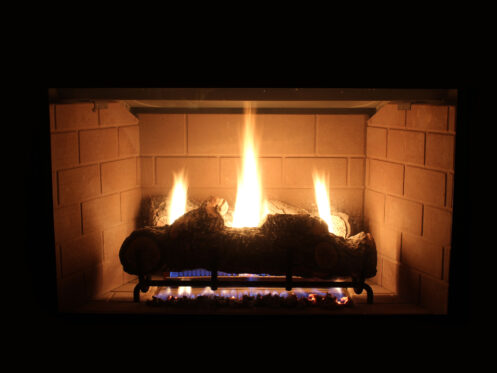Winter is the perfect season for snuggling near a fireplace and enjoying the coziness of your home. Gas fireplaces allow you to enjoy heat without the constant need for wood or pollution from particulate matter. Using your gas fireplace is more than just turning a knob and hoping for the best. A look at the top steps to take while gearing up for the winter season can help ensure that your gas fireplace operates at its peak performance level.
Review Your Owner’s Manual
Now is the perfect time to review the manufacturer’s guidelines for your fireplace. Each model may require different fireplace cleaning and maintenance commitments to keep the unit operational and safe. The user manual can serve as a refresher course to ensure that you locate and handle components correctly. If the manual differs from directions found on general checklists, follow the instructions outlined for your unique model. Homeowners who no longer have access to the manual should call the manufacturer or reach out to a trained contractor for assistance.
Check the Outdoor Vent
When your fireplace is dormant for months, outdoor debris can accumulate in your exterior vents and chimney. This debris can obstruct or block ventilation. Turning on your fireplace without clearing the debris can result in backdrafts that may increase the risk of carbon monoxide exposure or house fires. Remove any decaying leaves, twigs, cobwebs, old soot, or similar debris to help improve airflow. If you notice signs of infestation, such as nesting, contact an exterminator or pest control service immediately.
Examine Glass Fireplace Doors
It is important to examine your fireplace’s doors. For some fireplace models, this glass component more closely resembles a window, exterior covering, or removable insert. The purpose of the glass covering is to beautifully display your fireplace’s glowing flames, but the glass casing also has the important function of helping to contain any carbon monoxide produced during combustion. Check for any nicks, cracks, or holes that could otherwise allow carbon monoxide to escape. You should also check the corners or hinges of your glass doors to ensure that the covering forms a tight seal when closed.
Tidy the Inside of the Fireplace
Dirt and debris can accumulate on the ceramic logs, rocks, or beads within your gas fireplace. When you turn on the fireplace for the season, the burning of this debris can produce a foul or unpleasant odor. Experts advise that before you turn on or open the gas valve, wipe or clean the logs within the fireplace. You should also follow the manufacturer’s directions and return the fireplace logs to their exact position after cleaning. Placing the logs in the wrong position can inhibit combustion and result in carbon monoxide buildup. Check your user manual, and take a photo of the required location of the fireplace logs before you move them in any way. If you still feel unsure, you can have an HVAC technician inspect your fireplace before using it for the first time this season.
Clean or Replace Fireplace Accessories
In addition to interior logs, it is also important to remove dirt or dust from exterior accessories. Clean or polish any pokers or brush accessories to prevent unwanted debris from reentering the fireplace unit. Other accessories can include fireplace tongs, shovels, and the nearby rack or tool storage unit.
Remove Dust From the Blower
The fireplace’s blower is an important device responsible for circulating warm air throughout the room. Unfortunately, the blower can become clogged with dust or dirt during the warmer months of the year. Experts advise unplugging the blower and removing any obstructions or blockages before using the fireplace. Vacuum any debris that falls from the blower to prevent these particles from impacting the indoor air quality of your home.
Test the Thermostat
Before the start of the winter season, verify your thermostat’s communication function. The thermostat helps the fireplace maintain the correct setting and signifies when the unit should turn off upon reaching desired temperature levels. If your fireplace has a remote control, test the device as well to ensure that it works properly.
Evaluate the Pilot Light
It is imperative to look for any indications of problems with your fireplace’s pilot light. A defective pilot light can leak gas into your home and constitute a major safety hazard. Visually inspect the pilot light for exposed wires, strange flickering, or hardware deterioration. You should also check the surrounding burner assembly for unusual signs like burn marks or sooty buildup. If you notice these issues, reach out to an HVAC contractor before trying to use your fireplace.
Verify Gas Supply and Ignition
In addition to checking the pilot light, some manufacturers provide instructions for testing your fireplace’s gas supply and ignition. For example, any noticeably loose connections or gas regulators can increase the risk of a gas leak. Turn off the supply if you suspect a leak, and contact a technician for assistance. Any unusual noises at startup can also indicate an issue with the ignition and require professional intervention as well.
Check Your Carbon Monoxide Detector
Carbon monoxide is a colorless, odorless, and tasteless gas that can arise from the incomplete combustion of fuel. This gas is poisonous because it can interfere with the body’s ability to deliver oxygen to vital organs. Excessive carbon monoxide exposure can result in illness, coma, or even death. Before powering on a fireplace in the winter, check to make sure your home’s carbon monoxide alarms are functioning properly. Install new batteries or replace the alarm with a new device if needed.
Schedule a Professional Fireplace Inspection
Gas fireplaces require a routine inspection at least once each year. A professional inspection allows a trained HVAC technician to check the functionality of crucial components within your unit. For example, the contractor may check for gas leaks or defective sensors that can pose serious safety risks for all home occupants. The technician may also assess the fireplace’s flame quality and the overall energy efficiency of the unit. Some inspections include preventative maintenance tasks such as part lubrication or minor hardware repairs. You can also ask whether the contractor performs full-service tune-ups to help your gas fireplace live up to its maximum lifespan.
Get Help Today
Kalins Indoor Comfort offers fireplace services in Iowa, South Dakota, Nebraska, and the surrounding areas. We are the leading company in fireplace installation and maintenance throughout the Midwest. Our experience can install or upgrade your fireplace with your preferred color, material, style, and location in the home. We can also perform a host of fireplace maintenance, including firebox inspection, ventilation system tune-up, damper inspection, and chimney cleaning.
In addition to fireplace inspections and upkeep, we also offer other heating services like furnace installation, maintenance, or emergency repair. We can evaluate your residential thermostat or help you upgrade to a smart thermostat to keep your home comfortable during the winter. Once your home has reached a desirable temperature, our professional duct-sealing service helps prevent any heating loss from duct leakage. We can also install multi-zone or geothermal heating systems for maximum energy efficiency. Contact Kalins Indoor Comfort today to schedule an appointment.











